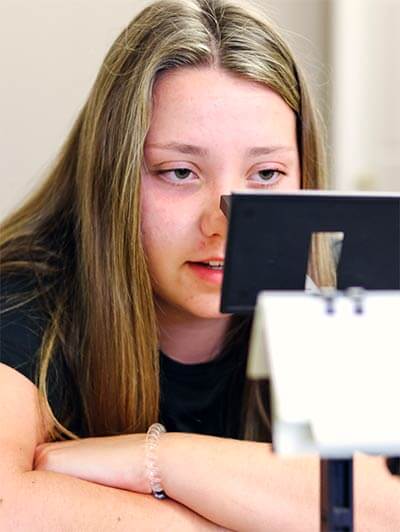
Our optometrist, Dr. Eric Weigel, has been trained to use visual performance tests, for children and adults to evaluate several important areas of vision that often go unchecked during standard “20/20” visual acuity tests. Our comprehensive vision exams include, but are not limited to, the following tests to evaluate the various aspects of vision:
Visual Acuity at Near and at a Distance
We test how clearly and accurately a person sees at both 20 feet and at close reading distance.
Eye Focusing (Accommodation) Skills
We test how well and quickly the eyes are able to adjust their focus on objects at different distances. The eyes’ ability—or inability—to rapidly and automatically adjust focus affects everything from participating in sports to reading and writing in educational and work settings. For example, children with focusing problems may struggle with school work and changing focus from the board to the work on the desk.
Eye Teaming/Eye Alignment
These tests asses how well your eyes work as a team. Problems with eye teaming and eye alignment can cause depth perception, blurred or double vision, and eye-hand coordination difficulties.
Eye Movement
These tests determine how well the eyes can perform tracking and fixing functions; for example, how well can a student go from reading a line of text at reading distance to following along with the teacher at the front of a class room. Tracking and fixation also affect hand-eye coordination and reaction time which are vital for athletes. Many times children with eye movement problems will skip words when reading or lose their place when reading.
Reversal Frequency
We test how well you mind your p’s and q’s, b’s and d’s and even short words like “was” and “saw.” When children over the age of 7 persistently confuse these letters, there may be a visual perceptual problem, in addition to an eye movement and a left/right awareness problem.
Visual Motor Integration Testing
These tests asses your ability to coordinate visual input with information from your other senses, such as touch (hand-eye coordination).
ReadAlyzer Computerized Reading Assessment
This test will assess the patient’s ability to make accurate eye movements while reading. The patient will wear a pair of goggles that will track exactly where the eyes are pointing while reading the passage. A short (10) question quiz is given to assess comprehension and validity of the test. These results will show any problems in eye movements that may be affecting the reading eye movements.
Why Is The Visual Performance Evaluation So Rigorous?
If this list of visual performance tests seems rigorous, you are right. The breadth and depth of these tests enable us to develop comprehensive therapy programs for our patients.
We recommend that all children seek out an optometrist for a comprehensive eye examination at least at the ages of 6-12 months, 3 years (prior to preschool entry) and at age 5 (the summer before kindergarten), then every year after. Early diagnosis of problems, like Amblyopia (Lazy Eye), Convergence Insufficiency (near vision disorder) and other problems, and correct treatment of the problems can help children overcome and possibly avoid struggling with learning disabilities like dyslexia and conditions like ADD/ADHD.
We can also use these tests to assess and develop treatment plans for all ages of people struggling with vision problems due to traumatic brain injuries, autism, whiplash and eye strain from computer usage or reading.
Call the Southeastern Indiana Vision Development Center to schedule an appointment for your optometric vision therapy evaluation today!

